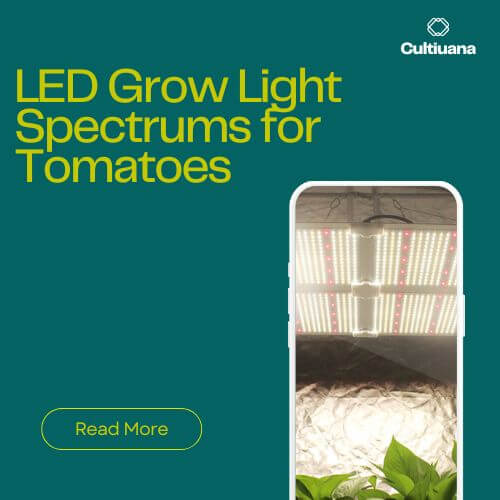Do Regular LED Lights Help Plants Grow
What are LED lights? A light-emitting diode (LED) is a semiconductor light source that emits light when current flows through it.
LED lights found their place in many applications within various industries, including your television, computer monitor, GPS device, and yes, even your grow lights!
If you’re growing plants indoors with artificial lighting, you may have heard of LED grow lights before.

These innovative lights combine an array of LEDs together to mimic the sun’s spectrum of white light and can be used to replace fluorescent or incandescent grow lights entirely.
So do regular LED lights help plants grow?
Do Regular LEDs Help Plants Grow

LEDs grow lights can be expensive, but not regular LED lights. If they work well enough to power plants and save you on your energy bill, regular light bulbs might be a great investment.
People often assume that in order to make up for the lack of natural light, they need expensive grow lights; when in reality, a regular LED light lamp can help plants grow just as well.
However, in some cases, a regular LED lamp won't work.
Why LED Lights Don't Work Well Sometimes

As we said previously, a regular LED lamp sometimes won't work as a grow light. Why?
LEDs come in all shapes and sizes. The most commonly known type is the lighting LED, but there are many different variations, including illuminators, LED bars, and LED lamps. For most of growers, LED lamps are what they use as grow lights for their indoor plants.
For of all, it depends on what kind of plant you are growing and which stage of growth do you use the regular LEDs.
If you grow leafy greens like lettuce, then you might want to target PPFD ~80 µmol/m2/s (PPFD) during seedling and ~150 µmol/m2/s (PPFD) during vegetative phase.
And for this case, a 2.2W LED bulb with 36-degree lenses can deliver 300 PPFD center spot and 100 PPFD in the outer edges, resulting in 200 PPFD average at 5" from the canopy.
If you are growing cannabis, they require high light intensity. The size of your cannabis plants will dictate how much PPFD they can handle.
If you have large plants, they can take up to 1500 µmol (PPFD) with the help of supplemental CO2. But remember, additional environmental factors such as temperature and relative humidity also play a role in how well your plants will grow.
For this case, a 600-1000 wattage LED grow light is needed to light your plants. A normal LED light won't have the same high PAR rating.
How Do Regular LEDs Differ From LED Grow Lights

Lighting purposes: In a residential or commercial environment, LED lights are used for illumination. Plants grow faster under LED grow lights.
Lighting Spectrum: Normal LEDs do have a color spectrum, but it may not be as comprehensive as that of grow lights. They emit light on a minimal amount. LED grow lights generate a broader spectrum of light, including both blue and red wavelengths.
Photosynthesis System: Regular LED lamps do not have any special characteristics of helping photosynthesis systems while LED grow lights can help support the process of photosynthesis by providing the light that plants need to grow.
Energy: Average LEDs are more energy efficient than an LED grow light. The latter requires more electrical power to provide lighting to plants.
Damage: LED lights has a special feature of covering to protect your eyes but LED grow lights damage your eyes.
Cost: Normal LEDs are much cheaper than LED grow lights.
Effect of LED Grow Lights on Plant Growth

LED grow lights are luminaires that emit light using LED chips in a modern and efficient way for growing plants.
With LED grow lights you can adjust the light intensity to match the needs of plants, a significant advantage over traditional lighting solutions.
Full spectrum is a spectrum that contains all colors and is most like sunlight.
Different colors of LED grow lights are matched to the specific intent.
The blue and red light spectrums affect root and flower formation. This means most plant types will go through a full growth cycle if they are exposed to both blue and red grow lights.
They experience the best growth when exposed to both blue and red lights and this type of light.
The wavelengths of PAR – Photosynthetically Active Radiation region – is essential for plant growth and LED grow light plays a key role in this entire process. It is the amount of light that most effectively stimulates photosynthesis in plants.
Blue and red light waves are found between 400 and 700 nanometers. As you approach 700nm, the PAR exposure increases.
As a plant grows, its light needs change. When a plant is a seed, it needs blue light, but as it matures, it needs more red light. You can figure out how much light a plant is getting by using special equipment that measures nanometers.
If you want your plants to grow healthy and productive, you need to make sure they're getting the right amount of exposure to the 400nm to 700nm range of light.
Each stage of a plant's growth cycle requires a different level of exposure, so it's important to keep an eye on your plants and adjust their light accordingly.
Adding other colors to the spectrum, such as green, far-red, and deep-blue, is like giving plants a multivitamin. It provides them with more information about their environment and overall results in healthier plants as well.
Final Thoughts
Throughout the past decade, LED grow lights have grown in popularity, often being used as main lighting source in indoor gardens.
LED grow lights are a type of light that is useful for growing plants, especially those that grow in soil. They come in all shapes and sizes, so you need to know the size you need before buying one. The shape of the grow light also affects how it will work.
The purpose of an LED grow light is to, well, light your plants! If you're confused about which kind of grow light to choose for your plants, it's important to consider what type of plants you're trying to grow.
Different plants have different lighting needs, so it's important to do your research before buying a fixture.
Depending on the type of light bulb used, we now know that even a regular LED light bulb can help plants grow. Make sure to take note of your plants’ progress whenever you make use of these regular lights. The signs they indicate will tell you if you need to replace them with a stronger LED grow light.




